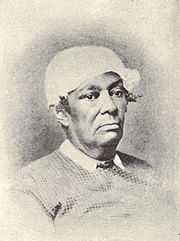Betsey Stockton
| Betsey Stockton | |
|---|---|
 Betsey Stockton, circa 1863 | |
| Born |
c. 1798 Princeton, New Jersey |
| Died |
October 24, 1865 Princeton, New Jersey |
Resting place | Cooperstown, New York |
| Occupation | Educator and Missionary |
Betsey Stockton (c. 1798–1865), sometimes spelled Betsy Stockton, was an African-American educator and missionary.
Life
She was born into slavery in the Princeton, New Jersey, about the year 1798. While a child, her owner Robert Stockton gave her to his daughter upon her marriage to Reverend Ashbel Green, president of the College of New Jersey (now Princeton University). She was temporarily sent to Green's nephew, the Reverend Nathaniel Todd, but returned to Green's household in 1816. In 1817 she was admitted as a member of the First Presbyterian Church in Princeton, and formally manumitted at that time. She remained as a paid domestic servant with the family, learned from reading in their library and home schooling by Dr. Green, and expressed a desire to go as a missionary to Africa. She also did some teaching at this time.
She learned of plans by Charles S. Stewart, a student at Princeton Theological Seminary and friend of the Green family, to go to Hawaii (then known as the Sandwich Islands) as a missionary. She expressed a desire to go with them. Dr. Green and her Sabbath school teacher wrote letters of recommendation to the American Board of Commissioners for Foreign Missions. She was commissioned by the Board as a missionary, and became the first single American woman sent overseas as a missionary. Her contract with the Board and with the Stewarts said that she went "neither as an equal nor as a servant, but as a humble Christian friend" to the Stewarts, and provided that she was not to be more occupied with domestic duties than the other missionaries.
The team set sail from New Haven, Connecticut on November 22, 1822 for a five month voyage. The Stewarts and Stockton settled at Lāhainā on Maui. She was the teacher of the first mission school opened to the common (non-chiefly) people of Hawaii. She also trained native Hawaiian teachers who took over from her upon her departure until the arrival of another missionary. She returned to the U.S. in 1825 due to Mrs. Stewart's poor health. A version of her Hawaiian diary was published in the Christian Advocate by Dr. Green in 1824 and 1825.
She stayed with the Stewart household until at least 1830. She taught briefly at an infant school in Philadelphia, Pennsylvania, established a school for Indians at Grape Island, Canada, and then returned to Princeton in 1835 and taught in its school for blacks until her death on October 24, 1865. In 1840, she helped found Princeton's First Presbyterian Church of Color which in 1848 was renamed the Witherspoon Street Church. She was buried in Cooperstown, New York alongside the Stewart family.
References
- Peterson, Barbara Bennett (2000). "Stockton, Betsey". American National Biography of the Day. Retrieved 2006-06-20.
- editors Wills, David W. and Raboteau, Albert J. (emeritus) (2000). "Betsey Stockton’s Journal". African-American Religion: A Historical Interpretation with Representative Documents. Retrieved 2006-06-20.
- "Princeton History". Princeton Town Topics. 2006. Retrieved 2006-06-20.
- Sarah Johnson and Eileen Moffett (Spring 2006). "Lord, Send Us". Christian History & Biography 90: 35.
- Charles Samuel Stewart (1828). Journal of a residence in the Sandwich Islands. J.P. Haven.
- Portraits of American Protestant Missionaries to Hawaii. Honolulu, Hawaii: Hawaiian Mission Children's Society; printed by the Hawaiian Gazette Co. 1901. p. 19. OCLC 11796269.
| ||||||||||||||
|